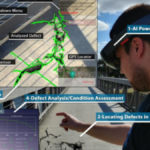As the Israel Defense Forces (IDF) face scrutiny for the unintended harm caused and civilian casualties, they have leveraged artificial intelligence (AI) to enhance the precision of targeting Hamas operatives and facilities.
Mark Montgomery, a senior fellow at the Foundation for Defense of Democracies’ Center on Cyber and Technology Innovation, highlighted the potential of AI and Machine Learning (ML) tools in streamlining the labor-intensive processes of target identification, evaluation, and assessment within the IDF’s operations in Gaza.
Montgomery emphasized the IDF’s commitment to minimizing collateral damage and civilian casualties, underscoring how AI and ML technologies can optimize the targeting approach for efficiency and effectiveness.
While AI tools can support specific recognition tasks and expedite target review and approval, human involvement remains integral in the targeting process, albeit with increased speed and accuracy.
On November 6, 2023, the IDF seized control of a military outpost utilized by the Hamas extremist group in the northern Gaza Strip, showcasing the ongoing integration of military AI technologies within the Army’s operations.
AI is predominantly utilized by the IDF to enhance targeting efficacy, with a focus on leveraging human oversight to validate decisions at each stage of the process.
In response to critiques regarding the significant destruction caused by IDF operations, Montgomery acknowledged the challenges but stressed the necessity of dismantling Hamas as a terrorist entity within a densely populated urban environment.
Montgomery refuted the notion that civilian casualties are a direct result of artificial intelligence, attributing such outcomes to the tactics employed by adversaries, including the use of civilians as shields and the strategic placement of war assets near civilian infrastructure.
Addressing concerns about the controversial nature of AI utilization in military operations, Montgomery acknowledged the complexities faced by the IDF in disproving misinformation and highlighted the role of AI in enhancing targeting precision while emphasizing the need for transparency in addressing such concerns.






